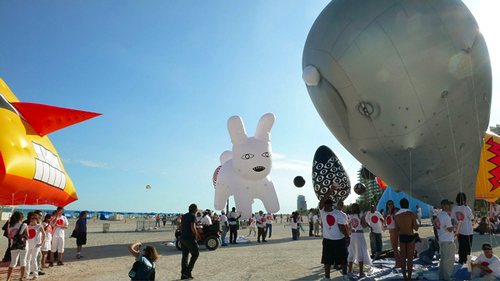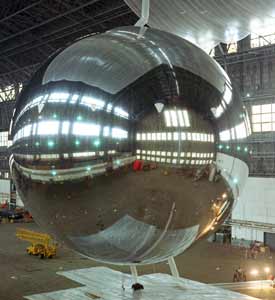
Yes, I do have a ton of other things I should be doing, but I can’t seem to get Project Echo out of my head. I really want to see this, 100+ foot spherical satellite balloon, “the most beautiful object ever to be put into space,” exhibited on earth. But where?
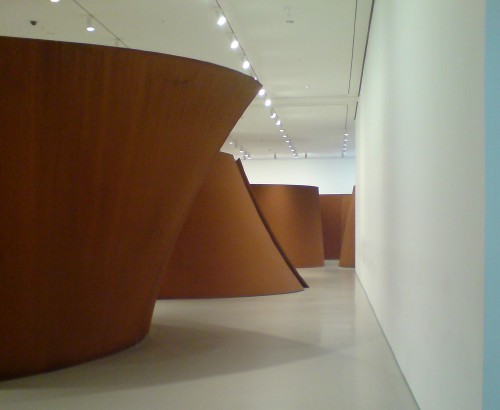
When MoMA was designing its new building, a lot of emphasis was placed on the contemporary artistic parameters that informed the structure. The gallery ceiling heights, the open expanses, the floorplate’s loadbearing capacity, even the elevators, everything was designed to accommodate the massive scale of the important art of our time: Richard Serra’s massive cor-ten steel sculptures.
And they did, beautifully, until just a few days ago.
But is there anything more anti-Serra, though, than a balloon? Made of Mylar, and weighing a mere 100 pounds? And yet at 100 feet in diameter, a balloon of such scale and volume, of such spatially overwhelming presence, it dwarfs almost every sculpture Serra has ever made?
The original Echo I was launched into space, but it was explicitly designed to be seen from earth. It was an exhibition on a global scale, seen by tens, maybe hundreds, of millions of people over eight years. People from the Boy Scouts to the king of Afghanistan organized watching parties. Conductors stopped mid-outdoor concert when Echo passed overhead.
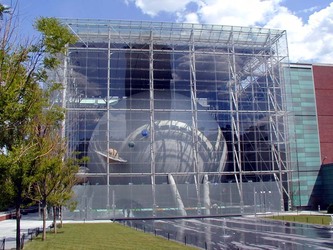
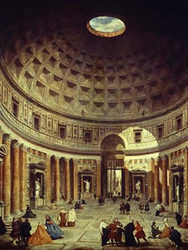
L: Hayden Planetarium = 87-ft diam. R: Pantheon = 142-ft. HEY!
What would an Echo satellite do to the art space it would be exhibited in? Are there even museums or galleries who could handle it? Or is the physical plant of the art world still organizing around the suddenly smallish-feeling sculptures of, say, Richard Serra?
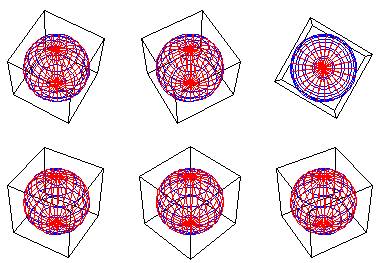
Echo satelloons were first seen–or shown, isn’t that why there’s a giant NASA banner draped across it?–in a 177-foot high Air Force blimp hangar in North Carolina. There are plenty of non-art spaces where an Echo could be exhibited, but that misses the whole point.
What art spaces in the world are able to physically accommodate an 10-story high Echo? A gallery or museum would need unencumbered, enclosed exhibition space of at least 120 feet in every dimension:
Suddenly all these atriums and rotundas you think are just grossly oversized turn out to be too small. I guess the art world’s space limitations will be the constraining parameter for my Project Echo exhibition.

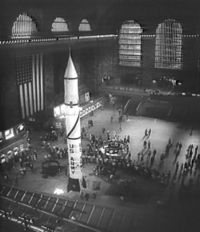
Maybe the only thing to do is to show it in a non-art-programmed space after all. Grand Central Station’s concourse is 160 feet wide and 125 feet high in the center. And as a bonus, a US Army Redstone rocket was exhibited there in mid-1957 [via wikipedia]. It was lowered through a hole cut in the constellation-decorated ceiling.
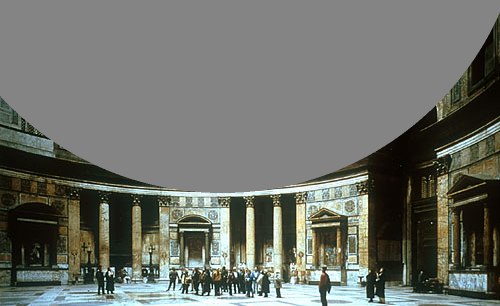
And then there’s the Pantheon, which is built on a 142-foot diameter sphere. As readers of Copernicus, Walter Murch, and BLDGBLOG will know, the Pantheon “may have had secretly encoded within it the idea that the Sun was the center of the universe; and that this ancient, wordless wisdom helped to revolutionize our view of the cosmos.” What better venue for displaying a satellite which indirectly helped revolutionize our view of the origins of the cosmos? And not that it’s necessary, but it even already has a hole in the roof.
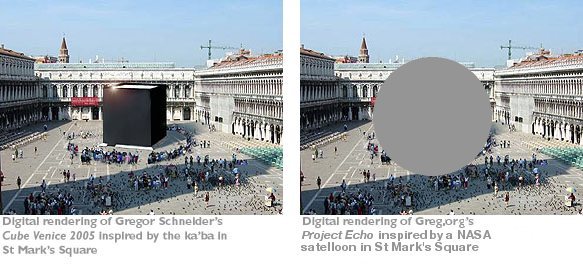
Unless I do it outside, Maybe in the Piazza San Marco, where Gregor Schneider’s 46-foot, black, shrouded Venice Cube sculpture was supposed to be installed during the 2005 Biennale. But would a recreation of a relic of American military and media propaganda be any more welcome in Venice than a replica of the Kab’aa? [So I just follow Schneider and install it two years later in the plaza in front of the Hamburg Kunsthalle? I’ll get right on that.]
Or maybe the answer’s right in front of me, and I just don’t want to admit it. Here’s what I wrote last winter about the Sky Walkers parade staged last December by Friends With You [and sponsored by Scion!]
It’s what I’ve always said Art Basel Miami Beach needed more of: blimps.
The only art world venue which can accommodate a 100-foot satelloon is an art fair.
Also of interest: A 1960 Bell Labs film, The Big Bounce, produced by Jerry Fairbanks, tells a very Bell-centric version of the Project Echo story. That horn antenna is something, though. [archive.org, via Lisa Parks’ proposal to integrate satellites into the traditional media studies practice]

